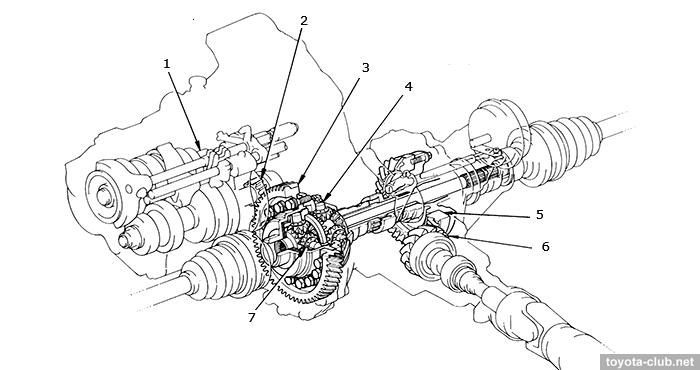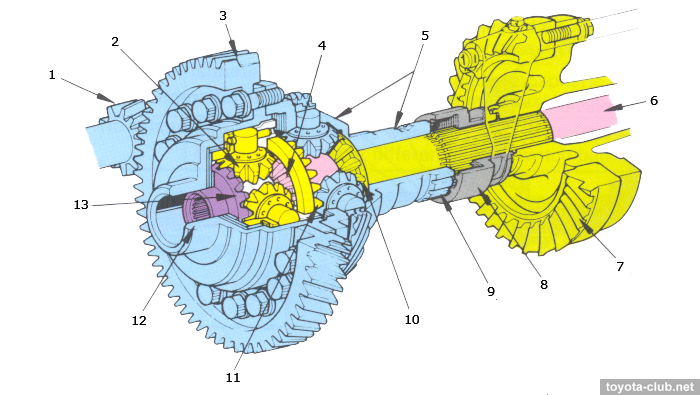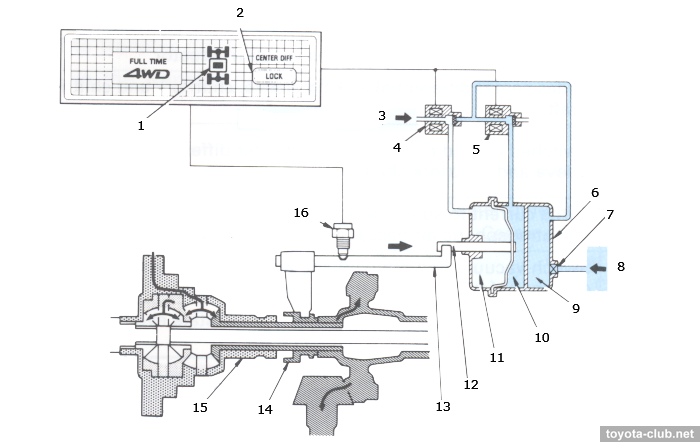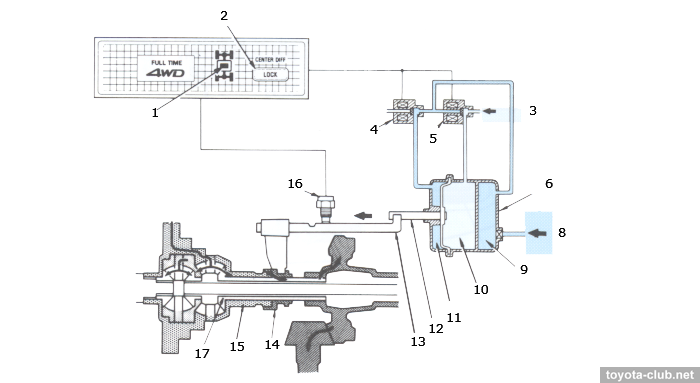(FF-based vehicles with MT)
|
Eugenio,77
Full-time all-wheel drive with a mechanical locking of the center differential used for MT models in the period of 1987-2001: Corolla/Sprinter 90..100..110, Corona/Carina 170, Vista/Camry 20, RAV4 10.
Construction The right case of center differential is integrated with a hollow shaft provided with "dog clutch" teeth. The center differential cases are installed on the ring gear. The right side gear is integrated with the splined-end hollow shaft. A dog clutch sleeve is installed on the splined portion to locking the center differential. The left side gear is integrated with the front differential case. Front differential right side gear is connected with the intermediate shaft that passes through the center differential right side gear.
Straight driving The power from the center differential drive gear is transmitted to the right and left case via the ring gear. Than the power is transmitted to the center differential right and left side gears via the pinion gears, that are mounted to the right case by the pinion shaft and spider. Than the power is transmitted from via hollow shaft of the right side gear to the transfer drive gear, and via driven gear to the propeller shaft. Also, the power from the differential left side gear is transmitted to the right and left front differential gears via the front differential case, pinion shafts, and pinion gears. Cornering While cornering, the turning radii of the front and rear wheels differ. The number of revolutions of the rear wheels is smaller than that of the front wheels, cause a difference of revolutions between the center differential right and left side gears, that is absorbed by the rotation of the center differential pinion gears.
Locking When one of the wheels (or both front or rear wheels) starts to spin, the driver can operate the center differential locking system to forcibly transmit the power to the wheel that is not spinning. (1) Center differential lock switch - off. VSV 1 and VSV 2 - off. VSV 1 draws vacuum from the vacuum tank to chamber A, VSV 2 draws atmospheric air to chamber В. The vacuum actuator diaphragm moves toward chamber A (right) and the connected rod moves to the right the locking sleeve, shift fork and shaft. The locking sleeve disengages from the case, the center differential operates free adjusting the rotational difference between the front and rear wheels. The indicator lights goes off.
(2) Center differential lock switch - pushed on. VSV 1 and VSV 2 - go on. VSV 1 draws atmospheric air to chamber A, VSV 2 draws vacuum from the vacuum tank to chamber В. The vacuum actuator diaphragm moves towards chamber В (left) and the connected rod moves to the left the locking sleeve, shift fork and shaft. The locking sleeve engages with the case via the dog clutch. The center differential case and the right side gear are locked to each other. The center differential pinion gear, left and right side gears are locked with the case and rotate as a unit. Torque is splitted evenly to the front and rear differentials. The lock indicator light goes on. If the dog clutch teeth of the locking sleeve are not aligned correctly with the teeth of the center differential case, the indicator light sometimes will not turn on due to dog clutch teeth not engaged with each other. Necessary to move the vehicle forward.
Center differential lock system (four-wheel drive models with manual transmission) The center differential lock system is provided for use only when the vehicle does not have enough traction to move itself out of the following situations. • All front wheels or rear wheels are off the ground or on a slippery surface. • One of the four wheels is off the ground or on a slippery surface. Operating precautions • If the front wheels and rear wheels are worn unevenly, the center differential may not lock or unlock smoothly. • Before locking the center differential, make sure the wheels have stopped spinning. • Unlock the center differential immediately after you finish using the center differential lock system. An indicator buzzer will sound while the center differential is being unlocked. • After you have pushed the center differential lock switch to lock and moved the vehicle a short distance, the indicator light in the instrument panelstays on. If the light either fails to come on or goes out, ask your Toyota dealer to check the electrical system and the locking mechanism. The center differential must be unlocked in normal driving. Locking the center differential will result in difficult cornering control. Do not drive on a dry paved surface with the center differential locked. This may damage the locking mechanism and the drive system. To lock the center differential: 1. Press the brake pedal and stop the wheel spinning. 2. Put the front wheels in as straightahead a position as possible. 3. Push the center differential lock switch and check that the indicator light in the instrument panel comes on. To unlock the center differential: 1. Put the front wheels in as straightahead a position as possible. 2. Push the center differential lock switch once again and check that the indicator light in the instrument panel goes out and that the indicator buzzer stops sounding. The indicator buzzer will sound while the center differential is being unlocked. It stops sounding when unlocking is completed. Sometimes complete unlocking of the center differential may take longer. If unlocking of the center differential is not completed, check the area around you for safety, then accelerate or decelerate, or move the vehicle backward. NOTICE. While the indicator buzzer is sounding, do not make turns, and do not put the vehicle into a garage. This may damage the locking mechanism and the drive system.
Toyota all-wheel drive. Review |
|







